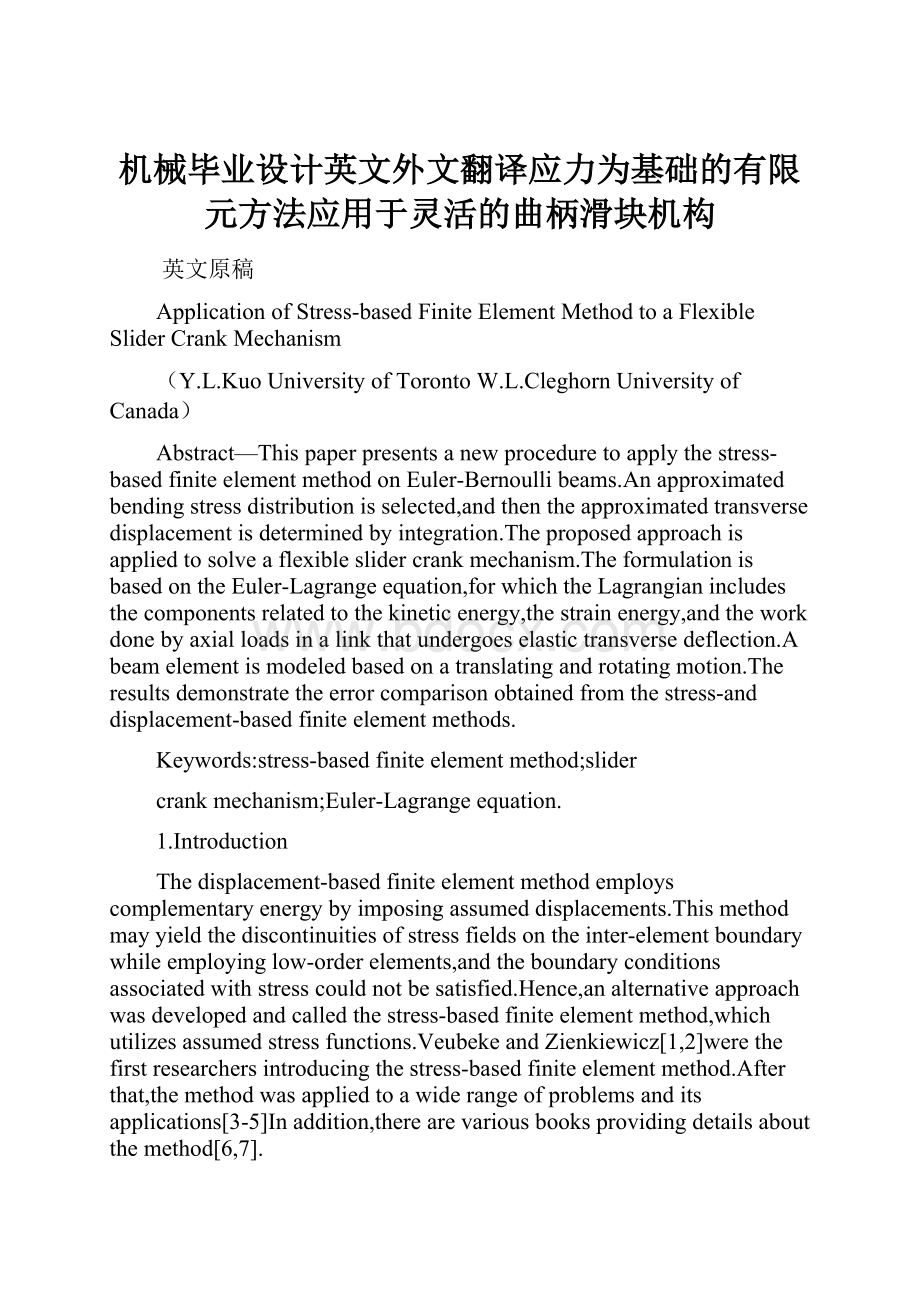机械毕业设计英文外文翻译应力为基础的有限元方法应用于灵活的曲柄滑块机构.docx
《机械毕业设计英文外文翻译应力为基础的有限元方法应用于灵活的曲柄滑块机构.docx》由会员分享,可在线阅读,更多相关《机械毕业设计英文外文翻译应力为基础的有限元方法应用于灵活的曲柄滑块机构.docx(24页珍藏版)》请在冰豆网上搜索。

机械毕业设计英文外文翻译应力为基础的有限元方法应用于灵活的曲柄滑块机构
英文原稿
ApplicationofStress-basedFiniteElementMethodtoaFlexibleSliderCrankMechanism
(Y.L.KuoUniversityofTorontoW.L.CleghornUniversityofCanada)
Abstract—Thispaperpresentsanewproceduretoapplythestress-basedfiniteelementmethodonEuler-Bernoullibeams.Anapproximatedbendingstressdistributionisselected,andthentheapproximatedtransversedisplacementisdeterminedbyintegration.Theproposedapproachisappliedtosolveaflexibleslidercrankmechanism.TheformulationisbasedontheEuler-Lagrangeequation,forwhichtheLagrangianincludesthecomponentsrelatedtothekineticenergy,thestrainenergy,andtheworkdonebyaxialloadsinalinkthatundergoeselastictransversedeflection.Abeamelementismodeledbasedonatranslatingandrotatingmotion.Theresultsdemonstratetheerrorcomparisonobtainedfromthestress-anddisplacement-basedfiniteelementmethods.
Keywords:
stress-basedfiniteelementmethod;slider
crankmechanism;Euler-Lagrangeequation.
1.Introduction
Thedisplacement-basedfiniteelementmethodemployscomplementaryenergybyimposingassumeddisplacements.Thismethodmayyieldthediscontinuitiesofstressfieldsontheinter-elementboundarywhileemployinglow-orderelements,andtheboundaryconditionsassociatedwithstresscouldnotbesatisfied.Hence,analternativeapproachwasdevelopedandcalledthestress-basedfiniteelementmethod,whichutilizesassumedstressfunctions.VeubekeandZienkiewicz[1,2]werethefirstresearchersintroducingthestress-basedfiniteelementmethod.Afterthat,themethodwasappliedtoawiderangeofproblemsanditsapplications[3-5]Inaddition,therearevariousbooksprovidingdetailsaboutthemethod[6,7].
Theoperationofhigh-speedmechanismsintroducesvibration,acousticradiation,wearingofjoints,andinaccuratepositioningduetodeflectionsofelasticlinks.Thus,itisnecessarytoperformananalysisofflexibleelasto-dynamicsofthisclassofproblemsratherthantheanalysisofrigidbodydynamics.Flexiblemechanismsarecontinuousdynamicsystemswithaninfinitenumberofdegreesoffreedom,andtheirgoverningequationsofmotionaremodeledbynonlinearpartialdifferentialequations,buttheiranalyticalsolutionsareimpossibletoobtain.Cleghornetal.[8-10]includedtheeffectofaxialloadsontransversevibrationsofaflexiblefour-barmechanism.Also,theyconstructedatranslatingandrotatingbeamelementwithaquinticpolynomial,whichcaneffectivelypredictthetransversevibrationandthebendingstress.
Thispaperpresentsanewapproachfortheimplementationofthestress-basedfiniteelementmethodontheEuler-Bernoullibeams.Thedevelopedapproachfirstselectsanassumedstressfunction.Then,theapproximatedtransversedisplacementfunctionisobtainedbyintegratingtheassumedstressfunction.Thus,thisapproachcansatisfythestressboundaryconditionswithoutimposingaconstraint.Weapplythisapproachtosolveaflexibleslidercrankmechanism.Inordertoshowtheaccuracyenhancementbythisapproach,themechanismisalsosolvedbythedisplace-basedfiniteelementmethod.Theresultsdemonstratetheerrorcomparison.
II.Stress-basedMethodforEuler-BernoulliBeams
ThebendingstressofEuler-Bernoullibeamsisassociatedwiththesecondderivativeofthetransversedisplacement,namelycurvature,whichcanbeapproximatedastheproductofshapefunctionsandnodalvariables:
Where
isarowvectorofshapefunctionsfortheithelement;
isacolumnvectorofnodalcurvatures,yisthelateralpositionwithrespecttotheneutrallineofthebeam,EistheYoung’smodulus,and
isthetransversedisplacement,whichisafunctionofaxialpositionx.
IntegratingEq.
(1)leadstotheexpressionsoftherotationandthetransversedisplacementasRotation:
Transversedisplacement:
Where
and
aretwointegrationconstantsfortheithelement,whichcanbedeterminedbysatisfyingthecompatibility.
SubstitutingEqs.
(2)and(3)into
(1),thefiniteelementdisplacement,rotationandcurvaturecanbe
expressedas:
wherethesubscripts(C),(R)and(D)refertocurvature,rotationanddisplacement,respectively.Byapplyingthevariationalprinciple,theelementandglobalequationscanbeobtained[11-13].
Table1:
Comparisonofthedisplacement-andthestress-basedfiniteelementmethodsforan
Euler-Bernoullibeamelement
III.ComparisonsoftheDisplacement-andStress-basedFiniteElementMethods
Themajordisadvantageofthedisplacement-basedfiniteelementmethodisthatthestressfieldsattheinter-elementnodesarediscontinuouswhileemployinglow-degreeshapefunctions.Thisdiscontinuityyieldsoneofthemajorconcernsbehindthediscretizationerrors.Inaddition,itmightuseexcessivenodalvariableswhileformulatingstiffnessmatrices.
Thestress-basedmethodhasseveraladvantagesoverthedisplacement-basedfinitemethod.Firstofall,thestress-basedmethodproducesfewernodalvariables(Table1).Secondly,whenemployingthestress-basedfinitemethod,theboundaryconditionsofbendingstresscanbesatisfied,andthestressiscontinuousattheinter-elementnodes.Finally,thestressiscalculateddirectlyfromthesolutionoftheglobalsystemequations.However,theonlydisadvantageofthestress-basedfinitemethodisthattheintegrationconstantsaredifferentforeachelement.
IV.GenerationofGoverningEquation
TheslidercrankmechanismshowninFig.1isoperatedwithaprescribedrigidbodymotionofthecrank,andthegoverningequationsarederivedusingafiniteelementformulation.Thederivationprocedureofthefiniteelementequationsinvolves:
(1)derivingthekinematicsofarigidbodyslidercrankmechanism;
(2)constructingatranslatingandrotatingbeamelementbasedontherigidbodymotionofthemechanism;(3)definingasetofglobalvariablestodescribethemotionofaflexibleslidercrankmechanism;(4)assemblingallbeamelements.Finally,theglobalfiniteelementequationscanbeobtained,andthetimeresponseofaflexibleslidercrankmechanismcanbeobtainedbytimeintegration.
A.Elementequationofatranslatingandrotatingbeam
Consideraflexiblebeamelementsubjectedtoprescribedrigidbodytranslationsandrotations.Superimposedontherigidbodytrajectory,afinitenumberofdeflectionvariablesinthelongitudinalandtransversedirectionsisallowed.TheEuler-Lagrangeequationisusedtoderivethegoverningdifferentialequationsforanarbitrarilytranslatingandrotatingflexiblemember.Sinceelasticdeflectionsareconsideredsmall,andthereisafinitenumberofdegreesoffreedom,thegoverningequationsarelinearandareconvenientlywritteninmatrixform.Thederivationoftheelementequationshasbeenpreciselypresentedin[8-10],andthissectionprovidesabriefsummary.
Inviewofhighaxialstiffnessofabeam,itisreasonabletoconsiderthebeamasbeingrigidinitslongitudinaldirection.Hence,thelongitudinaldeflectionisgivenas
whereu1isanodalvariable,whichisconstantwithrespecttothexdirectionshowninFig.2.Thetransversedeflectioncanberepresentedas
Thevelocityofanarbitrarypointonthebeamelementwithatranslatingandrotatingmotionisgivenas
where
istheabsolutevelocityofpointOofthebeamelementshowninFig.2;θ?
istheangularvelocityofthebeamelement;
arethelongitudinalandtransversedisplacementsofanarbitrarypointonthebeamelement,respectively;xisalongitudinalpositiononthebeamelementshowninFig.
2.
Ifweletρbethemassperunitvolumeofelementmaterial;A,theelementcross-sectionalarea,andLtheelementlength,thenthekineticenergyofanelementisexpressedas
TheflexuralstrainenergyofuniformaxiallyrigidelementwiththeYoung’smodulus,E,andsecondmomentofarea,I,isgivenas
Theworkdonebyatensilelongitudinalload,(i)P,inanelementthatundergoesanelastictransversedeflectionisgivenby[14]
Longitudinalloadsinamovingmechanismelementarenotconstant,anddependbothonthepositionintheelementandontime.Withthelongitudinalelasticmotionsneglected,thelongitudinalloadsmaybederivedfromtherigidbodyinertiaforces,andcanbeexpressedas
wherePRisanexternallongitudinalloadactingattherighthandendofanelement,andox
(i)aistheabsoluteeaccelerationofthepointOinthexdirectionshowninFig.2.
TheLagrangiantakestheform
SubstitutingEqs.(5-10)into(12),andemployingtheEuler-Lagrangeequations,thegoverningequationsofmotionforarotatingandtranslatingelasticbeamcanbeexpressedinthefollowingmatrixform:
where[Me],[Ce]and[Ke]aremass,equivalentdamping,andequivalentstiffnessmatricesofaelement,respectively;{Fe}isaloadvectorofanelement.Whenformulatingthemassmatrixofthecoupler,themassoftheslidershouldbetakenintoaccount.
B.Globalequationsofslidercrankmechanism
Fortheproposedapproachtosolveaflexibleslidercrankmechanism,theglobalvariablesarethecurvaturesonthenodes.Forassemblingallelements,itisnecessarytoconsidertheboundaryconditionsappliedtothemechanism.Sinceaprescribedmotionappliedtothebaseofthecrank,thereisabendingmomentatpointOshowninFig.1,i.e.,thecurvatureatpointOexists.ForpointsAandBshowninFig.1,wepresumethatbothpointsrefertopinjoints.Thus,thebendingmomentsandthecurvaturesatbothpointsarezeros.
SinceEq.(13)isamatrix-formexpressionintermsofthevectorofglobalvariables{φ},theglobalequationscanbeobtainedbydirectlysummingupallofelementequations,whichcanbeexpressedas
where[M],[C],[K]areglobalmass,dampingandstiffnessmatrices,respectively;{F}isagloballoadvector.
V.Numericalsimulationbasedonsteadystate
Therotatingspeed